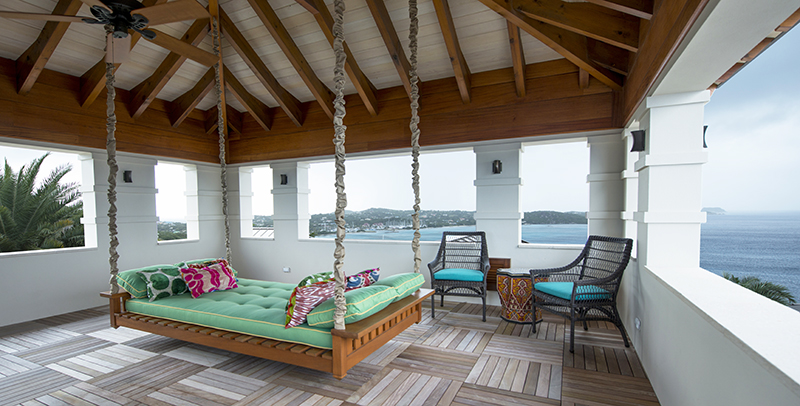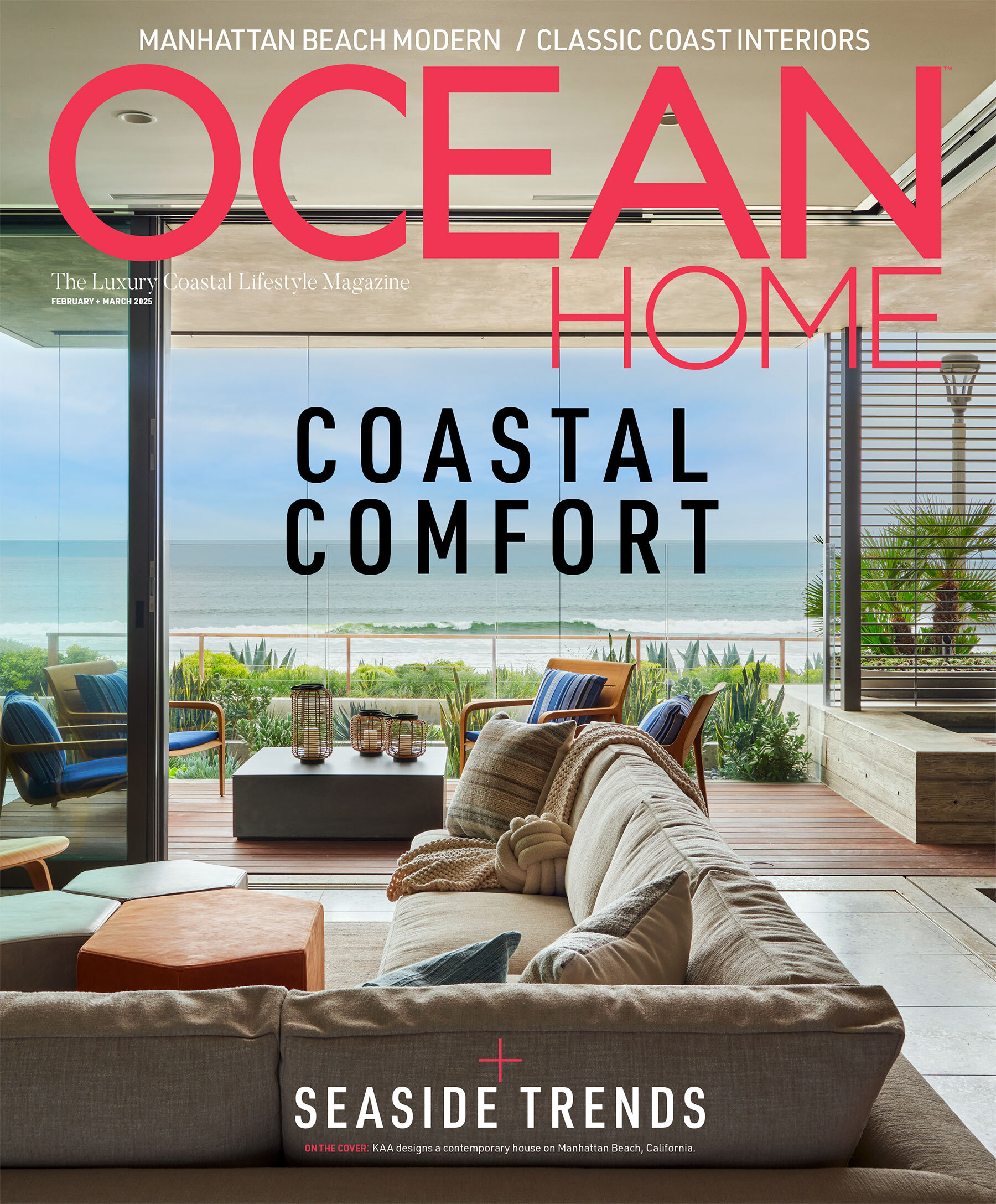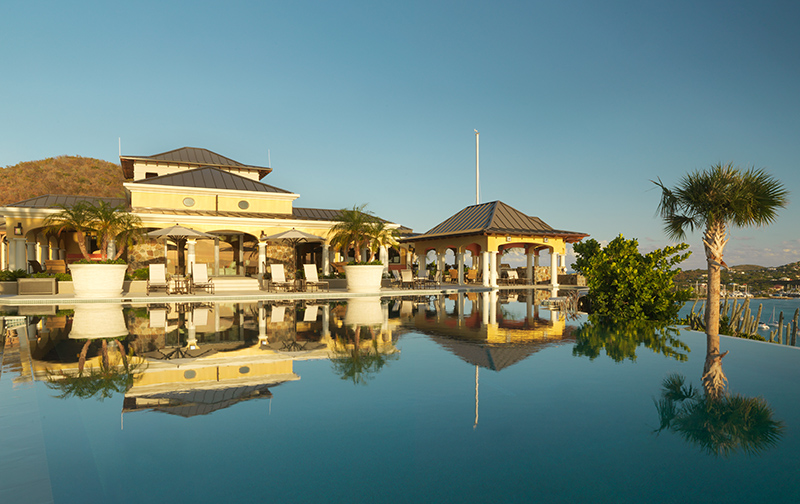A decade is a long time to take to build a home. Just ask Jim and Karli Hagedorn. They thought that long ago, their two children would have been frolicking for years in the infinity pool that surrounds Colison Point – their spectacular retreat atop the Caribbean island of Virgin Gorda – but it wasn’t to be.
Their two sons are now fully grown and married, with careers to boot. A grandchild is on the way. And the pool was completed only last year.
Their new home – actually a hilltop compound with majestic views of all the British Virgin Islands – turned out to be a long-term trial of vision and willpower. “It really was an endurance test,” says Karli, whose husband is the corporate visionary and CEO of Scotts Miracle-Gro.
And not just for the two of them. The interior designers at the helm of its decor bore more than their share of the burden, too. “It was a marathon,” says Nick Hertneck, a principal of the Los Angeles firm of Nicholas Lawrence Design.
Not to mention the landscape designer. “It seemed to take forever, but it took the time it had to take,” says Julie Moir Messervy, who heads up the Vermont-based landscape company that bears her name.
The Hagedorns’ venture on Virgin Gorda began in fits and starts. They discovered a brochure for the property at the Rosewood Little Dix Bay resort early in the 2000s, then hiked 250 feet up a goat path to view it. Its owners promptly took it off the market, later putting it back on.
Finally, the couple purchased it in 2004, and set about clearing the way for their home. “There was a lot of site work,” Karli says. “We had to blast the top of the hill.”
The four-acre property is on a promontory, a projection jutting out into the ocean on three sides, with a mountain on the fourth. “To perch a house up there is not the easiest thing to do,” says Messervy.
Early on, the Hagedorns had handed a sketch of what they wanted to architect Jon Osman, known for his work on a number of houses in the Caribbean, including that of Virgin founder Sir Richard Branson. “We gave Jon a drawing that he turned into a real design,” Karli says. “There are five structures on the property, so it was complicated. He did a nice job.”
But once the site and structural work were complete, management of the entire project fell to Hertneck and his design partner Lawrence Lazzaro. “It was as if we were starting fresh. We had a massive concrete foundation and cisterns to start from,” says Hertneck.
“Changes were made to the original plans, bathrooms reconfigured, door and window openings enlarged. The gallery upstairs, which was originally an enclosed space was reconfigured and became an outdoor space, and the outdoor dining pavilion was added,” Hertneck adds.
The design duo was tasked with creating an environment that would age gracefully and require the least amount of maintenance. It was also to feel intimate, accommodate an extended family, and give everyone staying at the house a sense of privacy.
“The design was a thrill,” Hertneck says. “It was creative and fanciful in some areas because the client gave us leeway to do what we wanted.”
  |
The logistics proved to be the most daunting element. Because it’s an island, everything on Virgin Gorda must arrive by boat, including a labor force with its own rules of engagement.
“Things happen more slowly here,” Hertneck adds. “They work eight months of the year, with six to eight weeks off for the holidays. And then they take off for the hurricane season.”
A team of 30 to 40 seasoned stonemasons worked on the project, coursing coral into the interior walls of blasted granite remnants, using hand tools and Old World methods. “That’s why it took so long,” says Hertneck. “But one of the things I like about the house is its sense of being handmade.”
Then there was the shipment of artisans’ work from Los Angeles to the Caribbean. “We’d consolidate it all in a warehouse in California and pack the containers ourselves,” Lazzaro says. “We’d inspect them to catch any problems, then we flew out to meet them to make sure there was no damage on the other end.”
Lighting and door fixtures were manufactured out of heavy brass to withstand maritime rust; limestone for floors was quarried, measured and cut in Italy; and Honduras mahogany panels were tailored for a library’s paneling, along with Ipe wood for beams. Spanish Cedar, Massaranduba and Sapele were also applied to marine grade plywood, some of their finishes painstakingly stained and distressed.
Not to mention the pivoting front doors, which were made in California, taken apart, shipped, and reassembled on site. Inspired by the massive entry doors of the airport on the neighboring island of Tortola – which are shaped like an aircraft’s wings – they stand open all day to reveal the main home’s eclectic foyer, where water flows ceaselessly from a Moroccan fountain. It’s a defining centerpiece for the space.
“I was in Morocco and found the fountain there and sent it back,” Karli says. “It sat in storage for four or five years from the time I bought it and put it in the house.” The foyer leads through an arched vestibule to the dining room where a table stands – 42 inches wide and 110 inches long – laid with a mosaic design inspired by a 19th century map of the British Virgin Islands.
On it, the owners can position scaled-down wooden ships to plan excursions throughout the Caribbean. “We embedded a piece of eight from the 16th century, one that we bought online from a pirate treasure site,” Hertneck says. “It marks the location where the property is.” The map is to scale, a unique collaboration between the interior designers and Virginia-based New Ravenna Mosaics. “There are probably 40,000 mosaic pieces or more,” says Sara Baldwin, of New Ravenna.
Interiors of the main residence are relatively dark, while the surrounding terraces are bathed in light reflected by the infinity pool. In between are spaces that are neither inside nor out – verandas and porches soaking in an impressionistic shimmer off peach and yellow walls. “It’s a beautiful experience of popping in and out of the light,” Messervy says.
The expansive ocean and island views from the inside edges of the infinity pool are equally dramatic. “The only way you know you’re not floating out on the sea is because of two palm trees anchored nearby,” she adds.
The five structures – main home, casitas for each of the two sons and their families, caretaker’s cottage, and games building – are all stitched together, separate but connected by coordinated gestures between those who designed its interiors and its landscape. The main house in particular appears to have been absorbed into its surroundings.
“The landscape architecture mission was to create a house that didn’t look like a new building,” says Hertneck.
“The plantings live up to the scale of the building, making it feel as though it has grown through the plants,” adds Messervy.
The Virgin Gorda compound is the seventh home the Hagedorns have built or renovated during the past 30 years, each with design assistance from Hertneck and Lazzaro. By far, it took the longest to complete.
So was it worth the wait? “We’ve got it and we enjoy it,” Karli says. “When we see our kids there – and next Christmas we’ll have our first grandchild there, too – I’d say yes.”
After all, in the whole scheme of things, a mere decade over two generations of a family is actually just a scant moment in time. nicholaslawrencedesign.com, jmmds.com.
Image Credits: Photos by Susan Teare.


